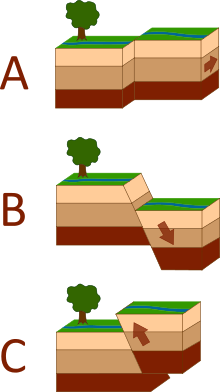
Back Geologiese breuke Afrikaans Falla (cheolochía) AN فالق Arabic চ্যুতি (ভূতাত্ত্বিক) Assamese Falla AST Разлом Bulgarian ভূ-চ্যুতি Bengali/Bangla Falla Catalan Zlom Czech Ffawt Welsh




A. Strike-slip
B. Normal
C. Reverse


A fault is a fracture, or break, in the Earth's crust (lithosphere). Some faults are active. Here, sections of rock move past each other. This sometimes makes earthquakes.
Faulting occurs when shear stress on a rock overcomes the forces which hold it together. The fracture itself is called a fault plane. When it is exposed at the Earth's surface, it may form a cliff or steep slope called a fault scarp.
The angle between the fault plane and an imaginary horizontal plane is called the dip angle of the fault. Faults may dip shallowly or steeply.
Faults are categorized into three types:
- A normal fault is one where the fault dips toward the downthrown block. Normal faults occur in rifted terranes, such as Mid-Ocean Ridges, the African Rift, and the Basin and Range Province of western North America. It is shown on geologic maps as a black line with either a block pattern on the downthrown side, or the letters U/D showing the upthrown and downthrown sides.
- A reverse fault (if steeply dipping) or thrust fault (if shallowly dipping)[1] is a fault where the fault plane dips toward the upthrown block. It is shown on the geologic map with triangular teeth pointing toward the upthrown side of the fault. Reverse and thrust faults shorten (horizontally) and thicken the crust. They are characteristic of collision origins.
- A transform (oceanic) or strike-slip (continental) fault is one where the relative motion is horizontal. The fault plane is usually vertical and can be horizontal. Famous examples of these include the San Andreas Fault of California, the Alpine Fault of New Zealand's south island, and the North Anatolian Fault in Turkey.
- ↑ "KGS--Petroleum: a primer for Kansas--Structure". Kansas Geological Survey. Retrieved 13 June 2010.